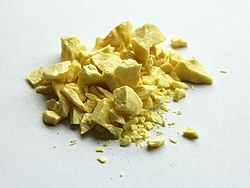The sixteenth element, Sulphur is given the symbol S. This element is found in its elemental form, often near volcanos and springs. It is a yellow crystalline solid, composed of rings of 8 Sulphur atoms.

It has been known about since ancient times and is the material referred to as "brimstone" in the bible.
Sulphur is a non-metal which sits under oxygen in the periodic table. Like oxygen if forms compounds with 2 other atoms -chemists say it is divalent. An example of a divalent compound of Sulphur is Hydrogen Sulphide - H2S. Hydrogen Sulphide is a colourless, poisonous gas that smells like rotten eggs.
It can also form molecules with different number of bonds. An example is Sulphur Dioxide, SO2 where it is joined by double bonds to both oxygens. Sulphur dioxide is sometimes used to preserve fruit for jam making.
Sulphur dioxide is produced when coal is burned. This SO2 reacts with water H2O in the atmosphere to form Sulphuric Acid H2SO4. This then falls as acid rain and affects crop growth and damages buildings.
In fact Sulphur forms compounds with all elements except the noble gases.
If you heat Sulphur with iron you get a new compound - iron sulphide. This experiment is often used to show the difference between a chemical mixture and a reaction producing a new material. Before heating this mixture the iron could be separated from the Sulphur using a magnet. Once it has been heated and reacted the new compound is not magnetic, nor can the magnet separate the iron from the Sulphur.
Many Sulphur containing compounds are smelly. You might be familiar with the sulphury smell from car's catalytic converters. Garlic and the Skunk also owe their smell to Sulphur containing compounds.
Experiment of the week
To examine the effect of Acid Rain on crops
You will need:
4 clear plastic tubs with lids (3kg Margarine containers are ideal.)
Kitchen roll
Pea seeds
Water
Vinegar
spoon
What to do:
Soak the peas overnight in water
In each of the 4 tubs cover the bottom with a few layers of kitchen roll. Dampen the kitchen roll well with water
Sprinkle pea seeds on the damp kitchen roll.
Label the containers 1,2 3 and 4
Put the lid onto container 1 and leave in a warm place
To container 2 add 1 spoon of vinegar. Put on the lid and leave alongside container 1.
To container 3 add 2 spoons of vinegar. Put on the lid and leave alongside container 1.
To container 4 add 3 spoons of vinegar. Put on the lid and leave alongside container 1.
Examine each day for the next 2 weeks and record your results.
Which set of peas will grow best?
Mold house analyze packages are revealing the toxins in our homes. A simple air analyze or surface sample taken from at house can provide you with answers to what has been triggering the respiratory or health issues destroying you or your close relatives.
ReplyDeletewater test kit.